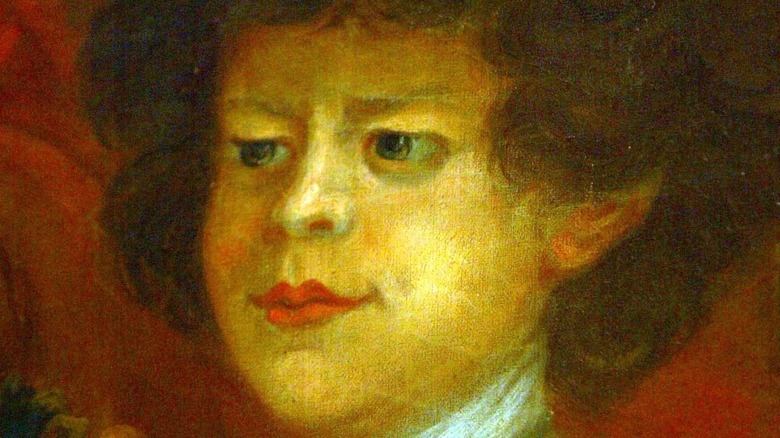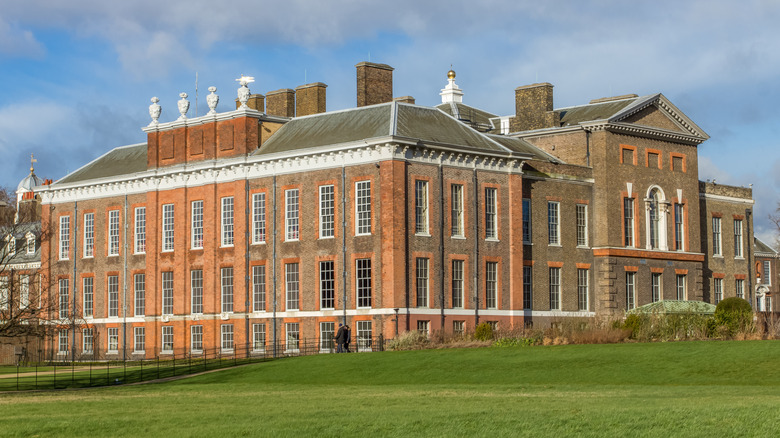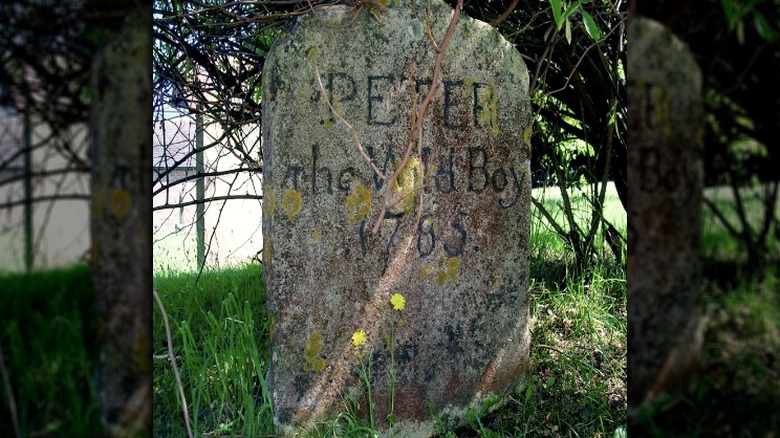The Truth About A Feral Child Who Was Kept As A Royal Pet
In 1725, a hunting party stumbled upon a young boy in what is now northern Germany's Hertswold forest. Although his specific age was unknown, the hunters estimated he was approximately 12 years old. As reported by History Today, the boy, who was later named Peter, was alone and appeared to have been living in the forest for some time, subsisting on a diet of plants, nuts, and acorns.
Visit Norwich reports the boy had long matted hair, long fingernails, and was sunburned. The hunters described him as "filthy," essentially nude, and seemly unable to speak. Instead, he communicated using a variety of "grunts and squeaks."
Although he could not walk upright, he was adept at climbing trees and navigating through the forest on all fours. History Today reports locals had complained that the boy periodically wandered into town to pick pockets and steal kisses from unsuspecting ladies.
Locals speculated the boy was abandoned in the forest as an infant and raised by wild animals. Visit Norwich reports the most prominent rumors suggested he was "suckled" by a bear, wild boar, or a wolf, although none of those animals were present in Hertswold forest.
The locals eventually began taking more of an interest in the child and gave him the name "Peter the Wild Boy." They also launched an effort to find his family. However, despite their best efforts, nobody ever claimed the boy or seemed to know where he came from.
Peter the Wild Boy moves to Kensington Palace
Stories about the "wild boy" eventually reached the ears of Great Britain's King George I, who was fascinated by the story and wanted the boy brought to the palace. As reported by Historic Mysteries, King George's daughter-in-law, Princess Caroline of Wales, arranged for Peter to be brought to Kensington Palace.
Although he was initially kept "as somewhat of a strange and entertaining kind of pet," Visit Norwich reports Peter was "treated kindly" while he was in their care.
As expected, Peter faced a lot of challenges as he attempted to adapt to a new lifestyle. Although he was expected to use utensils, he preferred to eat with his hands. He also resisted wearing clothing and seemed to be more comfortable sleeping on the floor than in a bed.
Princess Caroline hired Dr. Arbuthnot to arrange Peter's education and help him develop social skills. She also hired a team of servants to concentrate on his daily care and provide discipline when necessary. Historic Mysteries reports Peter eventually learned to walk upright and seemed to enjoy his new life. He especially enjoyed listening to music and developed a close relationship with some of the king's staff.
As reported by Visit Norwich, the wild boy was christened and baptized as Peter in 1726, and he remained a beloved member of the household until King George's death.
Peter's later life and eventual death
Following the death of King George I in 1727, Peter was passed from home to home until he was taken in by farmer James Fenn. As reported by Visit Norwich, Peter ran away from Fenn's farm in 1751 and was arrested in Norwich — where he was mistaken for a homeless man. As he could not verbally communicate, and they were unable to verify his identity, authorities sent him to a correctional institution called The Bridewell.
James Fenn placed an advertisement in a number of newspapers pleading for Peter's return, and was eventually reunited with him months after his incarceration. To prevent similar issues in the future, Peter was forced to wear a brass collar engraved with his address and identifying information.
Historic Mysteries reports Peter lived with James Fenn until his guardian died, and he then went to live with a farmer named Brill. Although he had a history of running away from home, Peter developed a strong relationship with Brill and never ran away while in his care.
According to legend, Peter refused to eat after Brill's death and essentially starved himself to death. Visit Norwich reports Peter died in 1785 at the age of 73. He is buried at St. Mary's Northchurch.
Peter may have been disabled
Peter's behavior and inability to verbally communicate were assumed to be caused by his time living in the wilderness. However, researchers now believe he may have been disabled.
In the 1700s, it was not uncommon for parents to abandon children who were physically or mentally impaired. As reported by Historic Mysteries, the infants or small children were simply left in the woods or other secluded areas — where they would ultimately die of exposure to the elements or starvation.
It is unclear whether Peter was purposely abandoned by his parents. However, historians believe Peter's appearance, behavior, and inability to verbally communicate indicate he had Pitt-Hopkins syndrome.
Historic Mysteries reports Pitt-Hopkins syndrome is a genetic disorder that is similar to autism. In addition to causing developmental delays, the disorder can cause physical abnormalities, including thick curly hair, hooded eyes, a prominent "cupid's bow" on the top lip, short stature, fused fingers or toes, and limited or no ability to communicate verbally. People with Pitt-Hopkins syndrome often prefer to go nude, as wearing clothing feels restrictive or uncomfortable to them.
The BBC reports personal accounts and a portrait of Peter, which was painted by William Kent, suggest he had many of the physical attributes and behaviors associated with the condition.



